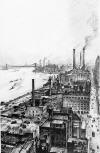
Enter the United Nations. With World War II over, the Allies were determined to secure the peace. The League of Nations had failed, and the victorious countries were determined to make its successor effective. The United States, famously, had rejected the League. This time around, political and diplomatic leaders around the world believed that the United States had to join, and lead, the postwar international organization. One of the ways to ensure this was to locate the U.N. in the United States -- instead of, say, Switzerland, where the League of Nations had its headquarters.
Forced to concentrate on the East Coast, U.N. officials set up temporary shop in the New York area, with various departments and functions scattered around Manhattan, the Bronx, Westchester and Lake Success. The need for a central headquarters was both obvious and pressing. So was the U.N.’s desire to stay in New York. But the city had no place to offer, and the U.N. began to explore sites in Boston and Philadelphia, with a Main Line location eventually becoming the most attractive.
Re-enter Blood Alley. During the war, real estate developer William Zeckendorf had quietly bought up much of the property in the area. With the war over, ambitious public and private plans could move forward, and Zeckendorf announced his intention to build something he called X-City, a blocks-long, multi-acre development with office towers, residential buildings and cultural facilities, including the long-sought new home of the Metropolitan Opera.
That sounded like an updated version of Rockefeller Center. Which was exactly Zeckendorf’s intention. He wanted to compete with the Rockefellers’ Midtown Art Deco jewel, although there was considerable doubt about whether he had the capital to do so.
Instead of calling Zeckendorf’s bluff, the Rockefellers decided to buy him out. With the U.N. poised to announce that it was moving to Philadelphia, the Rockefellers purchased the property Zeckendorf had painstakingly put together, then turned around and donated it to the international organization. (Zeckendorf reportedly made $2.5 million on the transaction -- a nice amount in that era.) It took Robert Moses only four days to execute the legal agreements that would eventually clear the area of slaughterhouses, breweries and tenements. Within five years, the U.N.’s landmark headquarters building had risen along the East River.
 The only thing that still blighted the area was the Third Avenue El. It cast a
perpetual gloom over a street lined with pawn shops and seedy bars. But the El
also provided a vital function, because only one subway line served Manhattan’s
East Side. So city officials proposed a deal -- after the El came down, it would
be replaced by a subway underneath Second Avenue.
The only thing that still blighted the area was the Third Avenue El. It cast a
perpetual gloom over a street lined with pawn shops and seedy bars. But the El
also provided a vital function, because only one subway line served Manhattan’s
East Side. So city officials proposed a deal -- after the El came down, it would
be replaced by a subway underneath Second Avenue. 